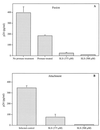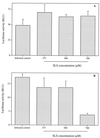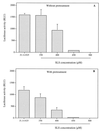Sodium lauryl sulfate abrogates human immunodeficiency virus infectivity by affecting viral attachment
- PMID: 11451679
- PMCID: PMC90636
- DOI: 10.1128/AAC.45.8.2229-2237.2001
Sodium lauryl sulfate abrogates human immunodeficiency virus infectivity by affecting viral attachment
Abstract
The microbicidal activity of sodium lauryl sulfate (SLS) against human immunodeficiency virus type 1 (HIV-1) was studied in cultured cells. Pretreatment of HIV-1(NL4-3) with SLS decreased, in a concentration-dependent manner, its infectivity when using 1G5 as target cells. In the absence of a viral pretreatment period or when 1G5 cells were pretreated with SLS, the surfactant-induced inactivation of viral infectivity was less pronounced, especially at concentrations between 375 and 550 microM. SLS had no effect on HIV-1 when the virus was adsorbed to 1G5 cells by a 2-h incubation period. SLS almost completely inhibited the fusion process by decreasing the attachment of HIV-1 to target cells. SLS also inhibited the infectivity of HIV-1-based luciferase reporter viruses pseudotyped with the amphotropic murine leukemia virus envelope (which enters cells in a CD4-, CCR5-, and CXCR4-independent manner), indicating that SLS may inactivate other envelope viruses. In contrast, no effect was seen with vesicular stomatitis virus envelope glycoprotein G (which enters cells through receptor-mediated endocytosis) pretreated with up to 700 microM SLS. SLS also decreased, in a dose-dependent manner, the HIV-1-dependent syncytium formation between 1G5 and J1.1 cells after a 24-h incubation. The reduction of luciferase activity was more pronounced when J1.1 cells (which express HIV-1 proteins on their surface) were pretreated with SLS rather than 1G5 cells. Taken together, our results suggest that SLS could represent a candidate of choice for use in vaginal microbicides to prevent the sexual transmission of HIV and possibly other pathogens causing sexually transmitted diseases.
Figures




Similar articles
-
Comparative study of mechanisms of herpes simplex virus inactivation by sodium lauryl sulfate and n-lauroylsarcosine.Antimicrob Agents Chemother. 2002 Sep;46(9):2933-42. doi: 10.1128/AAC.46.9.2933-2942.2002. Antimicrob Agents Chemother. 2002. PMID: 12183250 Free PMC article.
-
In vitro and in vivo evaluations of sodium lauryl sulfate and dextran sulfate as microbicides against herpes simplex and human immunodeficiency viruses.J Clin Microbiol. 2000 Jan;38(1):110-9. doi: 10.1128/JCM.38.1.110-119.2000. J Clin Microbiol. 2000. PMID: 10618073 Free PMC article.
-
Sodium lauryl sulfate, a microbicide effective against enveloped and nonenveloped viruses.Curr Drug Targets. 2002 Feb;3(1):17-30. doi: 10.2174/1389450023348037. Curr Drug Targets. 2002. PMID: 11899262 Review.
-
Inactivation of human immunodeficiency virus type 1 by nonoxynol-9, C31G, or an alkyl sulfate, sodium dodecyl sulfate.Antiviral Res. 1999 Oct;43(3):157-73. doi: 10.1016/s0166-3542(99)00044-3. Antiviral Res. 1999. PMID: 10551374
-
Sulfated polysaccharides extracted from sea algae as potential antiviral drugs.Gen Pharmacol. 1997 Oct;29(4):497-511. doi: 10.1016/s0306-3623(96)00563-0. Gen Pharmacol. 1997. PMID: 9352294 Review.
Cited by
-
Anti HIV-1 virucidal activity of polyamide nucleic acid-membrane transducing peptide conjugates targeted to primer binding site of HIV-1 genome.Virology. 2007 Jun 20;363(1):91-103. doi: 10.1016/j.virol.2007.01.016. Epub 2007 Feb 21. Virology. 2007. PMID: 17320140 Free PMC article.
-
Comparative study of mechanisms of herpes simplex virus inactivation by sodium lauryl sulfate and n-lauroylsarcosine.Antimicrob Agents Chemother. 2002 Sep;46(9):2933-42. doi: 10.1128/AAC.46.9.2933-2942.2002. Antimicrob Agents Chemother. 2002. PMID: 12183250 Free PMC article.
-
The role of amphiphilicity and negative charge in glycoprotein 41 interactions in the hydrophobic pocket.J Med Chem. 2009 Jul 23;52(14):4338-44. doi: 10.1021/jm900190q. J Med Chem. 2009. PMID: 19534533 Free PMC article.
-
Efficacy of Tenofovir 1% Vaginal Gel in Reducing the Risk of HIV-1 and HSV-2 Infection.Clin Med Insights Womens Health. 2014 Feb 13;7:1-8. doi: 10.4137/CMWH.S10353. eCollection 2014. Clin Med Insights Womens Health. 2014. PMID: 24741339 Free PMC article. Review.
References
-
- Aguilar-Cordova E, Chinen J, Donehower L, Lewis D E, Belmont J W. A sensitive reporter cell line for HIV-1 tat activity, HIV-1 inhibitors, and T cell activation effects. AIDS Res Hum Retrovir. 1994;10:295–301. - PubMed
-
- Alexander N J. Future contraceptives. Sci Am. 1995;273:136–141. - PubMed
-
- Bourinbaiar A S, Lee-Huang S. Comparative in vitro study of contraceptive agents with anti-HIV activity: gramicidin, nonoxynol-9 and gossypol. Contraception. 1994;49:131–137. - PubMed
Publication types
MeSH terms
Substances
LinkOut - more resources
Full Text Sources
Other Literature Sources
Research Materials

